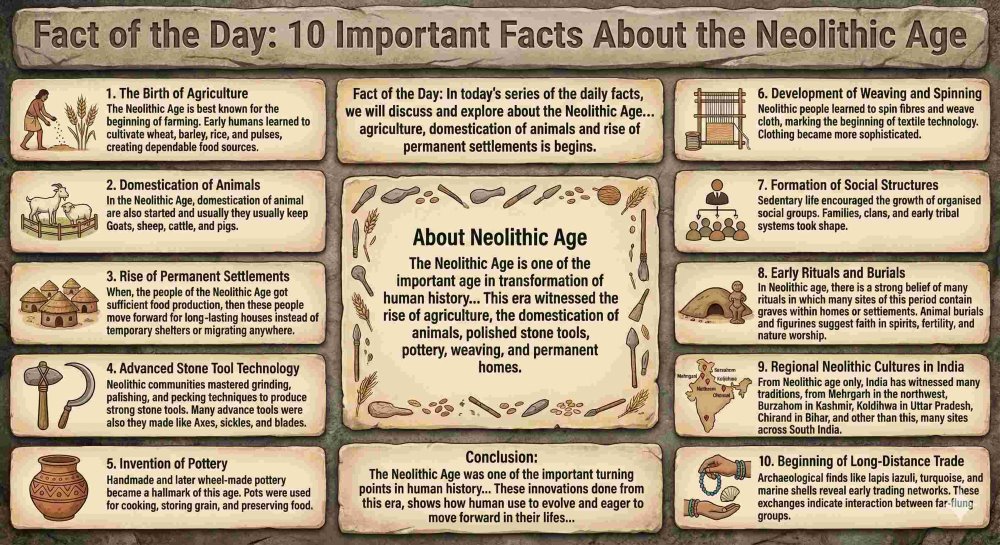Fact of the Day: In today’s series of the daily facts, we will discuss and explore about the Neolithic Age, which is one of the important age in the Stone age. In this age only, agriculture, domestication of animals and rise of permanent settlements is begins.
Daily-wise reading and knowing these facts, will help you to understand the core understanding of these topic, which will also help you in clearing various exams like UPSC, SSC, Banking and also many others state exams.
So, let’s explore the Neolithic Age, which is one of the important topic in Ancient Hostory in details.
| Also read these Facts: |
About Neolithic Age
The Neolithic Age is one of the important age in transformation of human history, when early communities and people who use to migrants and they are now wandering lifestyle to settled down for living at one place, rather then migrating.
This era witnessed the rise of agriculture, the domestication of animals, polished stone tools, pottery, weaving, and permanent homes.
As people learned to cultivate crops and tame livestock, they created stable food supplies that supported growing populations. Villages emerged, social roles expanded, and trade networks slowly developed.
From the Fertile Crescent to the Indus and Ganges valleys, these advancements laid the foundation for organised society, shaping the earliest roots of civilisation and human progress.
10 Important Facts About the Neolithic Age
1. The Birth of Agriculture
The Neolithic Age is best known for the beginning of farming. Early humans learned to cultivate wheat, barley, rice, and pulses, creating dependable food sources. This shift from hunting-gathering to cultivation laid the economic foundation for future civilisations.
2. Domestication of Animals
In the Neolithic Age, domestication of animal are also started and usually they usually keep Goats, sheep, cattle, and pigs. These animals helps them to get milk, meat, wool, and these animal helps them in reducing dependence on unpredictable wild resources and strengthening permanent settlement life.
3. Rise of Permanent Settlements
When, the people of the Neolithic Age got sufficient food production, then these people move forward for long-lasting houses instead of temporary shelters or migrating anywhere.
Neolithic homes, often made of mud, thatch, and wood, formed the earliest villages known in human history.
4. Advanced Stone Tool Technology
Neolithic communities mastered grinding, polishing, and pecking techniques to produce strong stone tools. Many advance tools were also they made like Axes, sickles, and blades, which were more supporting in farming, carpentry, and for daily tasks.
5. Invention of Pottery
Handmade and later wheel-made pottery became a hallmark of this age. Pots were used for cooking, storing grain, and preserving food. Distinctive patterns and textures also reveal early artistic expression.
6. Development of Weaving and Spinning
Neolithic people learned to spin fibres and weave cloth, marking the beginning of textile technology. Clothing became more sophisticated, and specialised craft skills started emerging within communities.
7. Formation of Social Structures
Sedentary life encouraged the growth of organised social groups. Families, clans, and early tribal systems took shape. Ownership of land and livestock led to new social responsibilities and economic roles.
8. Early Rituals and Burials
In Neolithic age, there is a strong belief of many rituals in which many sites of this period contain graves within homes or settlements. Animal burials and figurines suggest faith in spirits, fertility, and nature worship.
9. Regional Neolithic Cultures in India
From Neolithic age only, India has witnessed many traditions, from Mehrgarh in the northwest, Burzahom in Kashmir, Koldihwa in Uttar Pradesh, Chirand in Bihar, and other than this, many sites across South India, which shows the unique practises in various field of human toward development.
10. Beginning of Long-Distance Trade
Archaeological finds like lapis lazuli, turquoise, and marine shells reveal early trading networks. These exchanges indicate interaction between far-flung groups long before formal commerce existed.

Source: Gemini
Conclusion
The Neolithic Age was one of the important turning points in human history, as in this period only, there has been various transformations in human life, from farming to domestication and they do settled at one place, their advance tools and their social organisations. These innovations done from this era, shows how human use to evolve and eager to move forward in their lifes, also their civilisations, their cultures, economic and technological progress would not have been possible, if they are not involved toward human progress.
Comments
All Comments (0)
Join the conversation